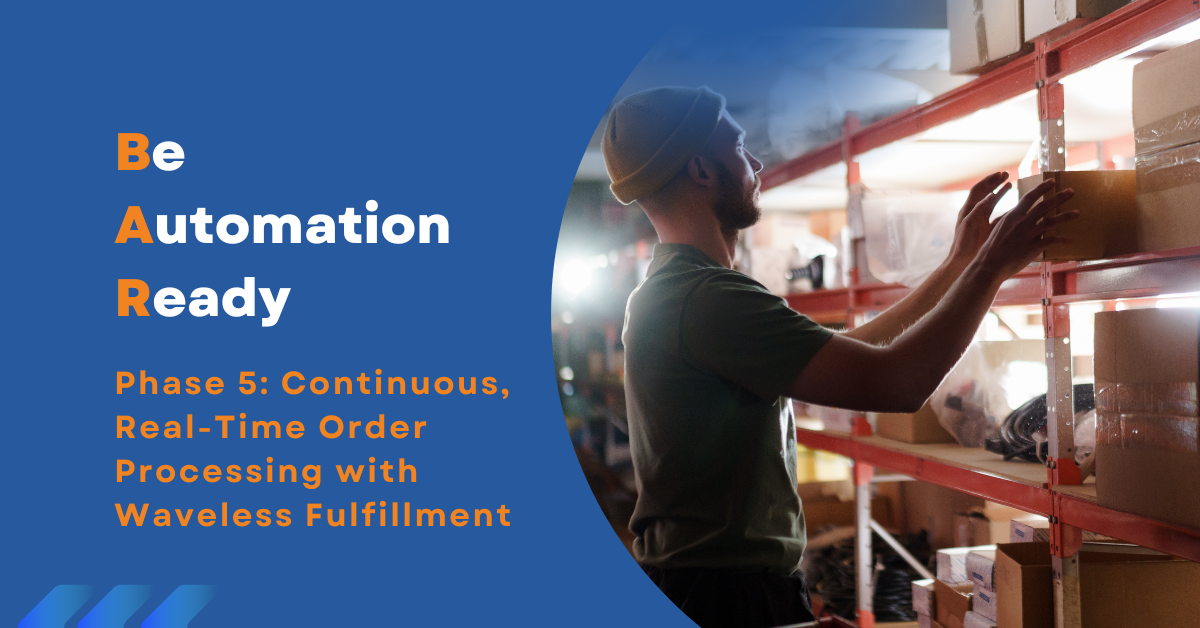


After progressing through manual assessment, tasking systems, assisted picking and goods-to-person (GTP) automation, we now arrive at Phase 5 of our Be Automation Ready (BAR) series: waveless fulfillment.
This phase shifts the paradigm from batch-based operations to a fluid, real-time model — boosting agility, throughput and operational intelligence.
Waveless fulfillment eliminates traditional wave-based batching in favor of continuous, real-time order processing. Instead of waiting for an entire batch to be ready before releasing work, orders are prioritized and executed dynamically as they enter the system. The result? Faster response times, lower latency and a demand-driven supply chain.
Recent studies have found that dynamic batching can boost warehouse efficiency by 27% less travel distance and 23% shorter travel times, while also reducing checklists by 30-50% and improving staff welfare through reduced fatigue.
Implementing waveless fulfillment does more than just accelerate throughput. It lays the operational and technological groundwork for multiagent orchestration (MAO).
1. Real-time work allocation → multi-agent decisioning
Waveless fulfillment introduces continuous task generation. MAO builds on this by making intelligent decisions across multiple agent types — robots, humans, pick stations — based on shared, real-time inputs.
2. Task flexibility → cross-agent collaboration
As waveless fulfillment enables tasks to be reassigned and reprioritized midstream, MAO takes it one step further. It uses smart orchestration logic to ensure those tasks are routed optimally across a heterogeneous fleet, including Autonomous Mobile Robots (AMRs), Automated Storage and Retrieval Systems (ASRS), and manual zones.
3. Visibility and context → centralized control
Waveless dashboards provide operators with a live view of throughput. MAO extends this by functioning as an intelligent control tower, coordinating priorities across systems and ensuring seamless interaction between automation layers.
In short, if waveless fulfillment is the engine that generates dynamic tasks, MAO is the brain that orchestrates and executes those tasks across multiple agents in real time.
Waveless fulfillment represents the natural evolution of modern warehouse execution, seamlessly integrating and enhancing the foundational technologies established in previous BAR phases while eliminating the constraints of traditional wave-based processing.
Intelligent tasking systems (Phase 2)
Phase 2 introduced rule-based task assignment. Waveless extends this to dynamic, on-the-fly prioritization, factoring in real-time order attributes and capacity.
Assisted picking (Phase 3)
Waveless relies on precise, guided task execution, which assisted picking technologies (e.g., voice, wearables, RF) make possible.
GTP automation (Phase 4)
GTP systems align perfectly with waveless logic: inventory is retrieved and delivered based on live order demand, not fixed pick waves.
The strategic shift to waveless fulfillment delivers advantages across operational efficiency, resource optimization, scalability and decision-making, positioning forward-thinking distribution centers to excel.
Faster fulfillment cycles
No batching means immediate execution — orders are picked, packed and shipped the moment they’re ready.
Smarter resource utilization
Labor and automation are deployed based on urgency, location, and availability. This eliminates idle hands and underused bots.
Elastic and scalable
Whether it’s peak season or a last-minute flash sale, waveless fulfillment flexes in real time to meet demand.
Data-driven decisions
Live analytics, predictive alerts and fulfillment KPIs give supervisors total visibility and rapid response capabilities.
Transitioning to waveless fulfillment requires a strategic, phased approach that upgrades both your technology infrastructure and operational mindset, creating a seamless ecosystem where orders flow continuously from receipt to shipment without batch constraints.
1. Upgrade your tasking layer
Ensure that dynamic task generation and prioritization is supported. This is the foundation for a solid WES.
2. Integrate picking and GTP systems in real time
Assisted picking and GTP systems have to communicate with the task engine continuously.
3. Train for flow, not batches
Operators need to adapt to a new rhythm that’s driven by constant prioritization instead of planned wave releases.
4. Track KPIs relentlessly
Speed, accuracy and resource efficiency should be monitored daily to calibrate your orchestration logic.
As Gartner reports in “Apply an Architectural Framework to Stratify Warehouse Management Systems,” “The combination of high levels of complexity with rapid business change demands adaptable systems.” Waveless fulfillment is that system, one that powers the strategic leap from automation to orchestration.
In our final Be Automation Ready installment, we’ll explore the frontier of warehouse intelligence — robotic orchestration, autonomous task execution and AI-driven optimization.